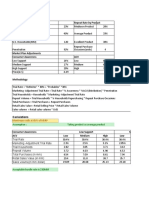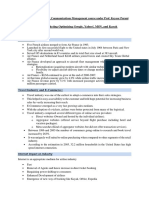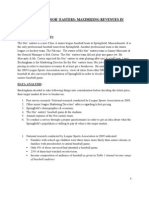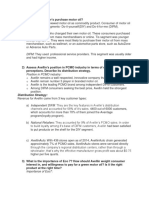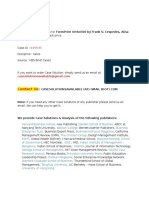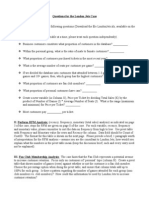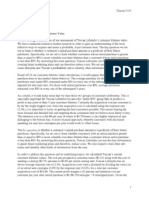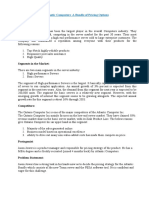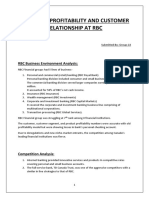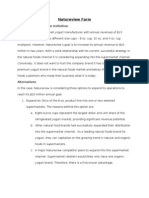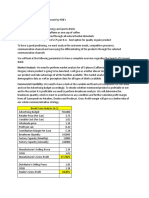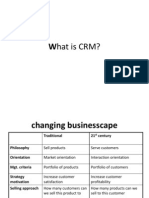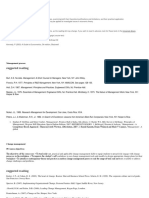London Jets, RFM Analysis - Group 9, Section B Current Scenario
London Jets, RFM Analysis - Group 9, Section B Current Scenario
Uploaded by
Harshita JhaCopyright:
Available Formats
London Jets, RFM Analysis - Group 9, Section B Current Scenario
London Jets, RFM Analysis - Group 9, Section B Current Scenario
Uploaded by
Harshita JhaOriginal Title
Copyright
Available Formats
Share this document
Did you find this document useful?
Is this content inappropriate?
Copyright:
Available Formats
London Jets, RFM Analysis - Group 9, Section B Current Scenario
London Jets, RFM Analysis - Group 9, Section B Current Scenario
Uploaded by
Harshita JhaCopyright:
Available Formats
London Jets, RFM Analysis - Group 9, Section B
Current Scenario
Chris Harri, the Marketing Manager of London Jets, is feeling the pressure as:
1. Management planning to sell the Hockey franchise due to of poor performance - low
sales & revenue
2. Saw mediocre results from a high budget ad campaign
Chris has been tasked with increasing attendance and implementing customer retention
programs in order to increase ticket sales and overall revenue.
Obstacles:
1. Improper customer segmentation
2. Inadequacy of customer data
3. Customer retention decreasing Y-o-Y
Solution
R – Recency, F – Frequency, M - Monetary
The basic premise of RFM is that customers who have purchased more recently, more
frequently and have spent more with the company are the best prospects for future direct
marketing campaigns. RFM analysis helps marketers visualize and quickly identify important
customer segments.
Analysis:
We recommend that the London Jets can achieve their goals through effective target marketing
to the most valuable customer segment. For this, we performed the following analysis.
● Business customers constitute 18% of all customers
● The ratio of male of female customers is 1.94:1
● 40% of customers purchased tickets in 2001
● Only 3% of the customers are fan club members
● Out of 3000 customers, 1805 attended only 1-3 games per year
RFM Analysis of 3000 customers:
● 90 fans score 5’s in Recency, Frequency, and Monetary
● 147 fans score the lowest on all three parameters of the analysis
Target profile of the 90 top scorers (includes undisclosed)
● Type: 63% Male, 20% Female, 17% Business
● Age: Median Age: 36.5 Years
● Marital Status: 45% Single, 55% Married
● Income: Average Income: $49,943
● 17% are Fan Club Members
● Vehicle Owners: 85% Own Vehicles
● 39% subscribe to magazines
● Nearly twice as many men attend games than women
● Fan Club Members continue to outspend non-members year over year
Conclusion:
Based on the RFM Analysis, the most desirable customers are the predominantly male, and
noticeably, not Fan Club Members (only 17%). The highest spenders belong to the age group
26-45 years while the lowest spenders are under 25 and over 55.
Fan club members attend 55% more games and spend 34% more on average than non-
members.
Recommendation:
● Increase fan club members incentives & give perks that are attractive for men between
the age 25-45 as they spend more and attend more games
● Increase advertisements in magazines that are popular among the target profile
● Strengthen relationships with businesses through incentives or specials
● Selling special 2 and 4 packs to increase the number of seats per customer per game
Gender 63% Male
20% Female
17% Business
You might also like
- Montreaux Chocolate USA CalculationsDocument3 pagesMontreaux Chocolate USA CalculationsAbi50% (2)
- Maru BattingDocument28 pagesMaru BattingRealChiefNo ratings yet
- Eco7: Launching A New Motor Oil Case Study SolutionDocument2 pagesEco7: Launching A New Motor Oil Case Study SolutionRahul AgarwalNo ratings yet
- Grop8 - ID Case Assignment No.1Document2 pagesGrop8 - ID Case Assignment No.1Poornima SaiNo ratings yet
- Case Analysis Air France - EPGCMM 11 008Document4 pagesCase Analysis Air France - EPGCMM 11 008arnab pramanik50% (2)
- Purple Innovation, Inc: The Online To Offline Marketing ChallengeDocument3 pagesPurple Innovation, Inc: The Online To Offline Marketing ChallengeAnoushka BhatiaNo ratings yet
- Group9 - SectionB - TruEarth Case AnalysisDocument3 pagesGroup9 - SectionB - TruEarth Case AnalysisKARAN SEHGALNo ratings yet
- Nor' Easters Maximizing RevenuesDocument8 pagesNor' Easters Maximizing RevenuesVruhali Soni100% (1)
- Marketing Case Study 1Document3 pagesMarketing Case Study 1Rakshita Asati100% (1)
- Medi-Cult Finalversion PDFDocument5 pagesMedi-Cult Finalversion PDFMohamed Hosny ShokryNo ratings yet
- Case Solution For Formprint Ortho500Document2 pagesCase Solution For Formprint Ortho500mati massini100% (1)
- Staffing Needs and Scheduling PoliciesDocument30 pagesStaffing Needs and Scheduling PoliciesErika Mae100% (2)
- Giant Consumer Products Case Analysis BDocument7 pagesGiant Consumer Products Case Analysis BSuman BandyopadhyayNo ratings yet
- LondonJets BUAD820 Case Team6Document10 pagesLondonJets BUAD820 Case Team6Rajnesh kumar kundnaniNo ratings yet
- L'Oréal of Paris: Bringing "Class To Mass" With PlénitudeDocument30 pagesL'Oréal of Paris: Bringing "Class To Mass" With Plénitudeariefakbar100% (6)
- London Jets CaseDocument2 pagesLondon Jets CaseAnand KV50% (2)
- Metabical Positioning and Communications Strategy For A New Weight Loss Drug PDFDocument8 pagesMetabical Positioning and Communications Strategy For A New Weight Loss Drug PDFDivyagarapatiNo ratings yet
- Metabical: Pricing, Packaging, and Demand Forecasting For A New Weight-Loss DrugDocument9 pagesMetabical: Pricing, Packaging, and Demand Forecasting For A New Weight-Loss DrugGaurav SinghNo ratings yet
- Clean Edge RazorDocument2 pagesClean Edge RazorSalil AggarwalNo ratings yet
- Case Submission - Dell Computers (A)Document3 pagesCase Submission - Dell Computers (A)Anmol YadavNo ratings yet
- Nestle Case Analysis FinalDocument6 pagesNestle Case Analysis FinalSandeep Kumar100% (1)
- Hummus Bar IB Group 1Document4 pagesHummus Bar IB Group 1srishti mishraNo ratings yet
- Wintel AnalysisDocument11 pagesWintel AnalysisSrikanth Kumar Konduri100% (2)
- FormPrint Ortho 500Document7 pagesFormPrint Ortho 500Garima Rajpoot100% (2)
- MetabicalDocument5 pagesMetabicalAsri Marwa UmniatiNo ratings yet
- Tuscan Lifestyles Case, Customer Lifetime ValueDocument4 pagesTuscan Lifestyles Case, Customer Lifetime ValueJeff Lien100% (4)
- Department of Management Studies Marketing Management: Case Study ReportDocument16 pagesDepartment of Management Studies Marketing Management: Case Study ReportAakanksha Panwar100% (1)
- Choosing The Right Metrics For Listerine Brand Management in Brazil Case Analysis and Case SolutionDocument10 pagesChoosing The Right Metrics For Listerine Brand Management in Brazil Case Analysis and Case SolutionShikha SidanaNo ratings yet
- Atlantic Computers: A Bundle of Pricing OptionsDocument4 pagesAtlantic Computers: A Bundle of Pricing OptionsFree GuyNo ratings yet
- CUSTOMER PROFITABILITY AND CUSTOMER RELATIONSHIP AT RBC - Section1 - Group18Document3 pagesCUSTOMER PROFITABILITY AND CUSTOMER RELATIONSHIP AT RBC - Section1 - Group18ananditaNo ratings yet
- NEstle Case Analysis - Yogesh JadhavDocument7 pagesNEstle Case Analysis - Yogesh JadhavyogeshNo ratings yet
- Case AnalysisDocument7 pagesCase AnalysisParth KhadgawatNo ratings yet
- Case Study For Account ManagementDocument11 pagesCase Study For Account ManagementPranay JhaNo ratings yet
- BSBHRM405 Support The Recruitment, Selection and Induction of StaffDocument7 pagesBSBHRM405 Support The Recruitment, Selection and Induction of StaffGreysonNo ratings yet
- Chap - 1 Historical Development of TQMDocument4 pagesChap - 1 Historical Development of TQMluciantoppo100% (4)
- Saffola Cooking Oil - The Repositioning JourneyDocument15 pagesSaffola Cooking Oil - The Repositioning JourneyShruti Mandal67% (3)
- Dendrite InternationalDocument6 pagesDendrite InternationalRajan MishraNo ratings yet
- Case Analysis - Wright Line, Inc. (A)Document8 pagesCase Analysis - Wright Line, Inc. (A)ayush singlaNo ratings yet
- Natureview Farm Case StudyDocument6 pagesNatureview Farm Case Studythemitten550% (1)
- Southwestern Ohio Steel Company LPDocument5 pagesSouthwestern Ohio Steel Company LPAbhimanyu DevNo ratings yet
- BBVA Compass: Marketing Resource Allocation: Ho Kim, Ph.D. Assistant Professor of MarketingDocument27 pagesBBVA Compass: Marketing Resource Allocation: Ho Kim, Ph.D. Assistant Professor of MarketingJoaquín Norambuena Escalona100% (1)
- BM MBA06071 Jaswinder SinghDocument6 pagesBM MBA06071 Jaswinder SinghJaswinder SinghNo ratings yet
- Case Analysis - Virgin MobilesDocument5 pagesCase Analysis - Virgin MobilesKeerthi PurushothamanNo ratings yet
- TiVo 2002 Consumer BehaviourDocument11 pagesTiVo 2002 Consumer BehaviourVijaya Suryavanshi100% (1)
- Case Summary of PSI Social MarketingDocument3 pagesCase Summary of PSI Social MarketingviyahooNo ratings yet
- Strides Arcolab Limited - PCBDocument15 pagesStrides Arcolab Limited - PCBNAMI100% (1)
- Goodyear - The Aquatred LaunchDocument20 pagesGoodyear - The Aquatred LaunchRonak GildaNo ratings yet
- B2B - Group 3 - Jackson Case StudyDocument5 pagesB2B - Group 3 - Jackson Case Studyriya agrawallaNo ratings yet
- Market Analysis: We Need To Perform Market Analysis For All 3 Places (California, Washington andDocument3 pagesMarket Analysis: We Need To Perform Market Analysis For All 3 Places (California, Washington andshivam chughNo ratings yet
- Indian Institute of Management, Indore: The PCRA: Social Marketing Campaign For Petroleum ConservationDocument4 pagesIndian Institute of Management, Indore: The PCRA: Social Marketing Campaign For Petroleum ConservationKOTHAPALLI VENKATA JAYA HARIKA PGP 2019-21 BatchNo ratings yet
- Consolidated Drugs Inc - B4Document11 pagesConsolidated Drugs Inc - B4Vaibhav Singh50% (2)
- End Point Model CaseDocument8 pagesEnd Point Model CaseSAURAV KUMAR GUPTANo ratings yet
- Metabical-Forecasting, Pricing and Packaging StrategyDocument4 pagesMetabical-Forecasting, Pricing and Packaging StrategyVinit Vijay Sankhe100% (1)
- BPMM6013 Marketing Management: Eco7: Launching A New Motor OilDocument26 pagesBPMM6013 Marketing Management: Eco7: Launching A New Motor OilNithin kumarNo ratings yet
- Classic Knitwear Case (Section-B Group-1)Document5 pagesClassic Knitwear Case (Section-B Group-1)Swapnil Joardar100% (1)
- Analysis of TruEarthDocument4 pagesAnalysis of TruEarth9874567100% (1)
- GBS Group 7 - Blue Ridge SpainDocument16 pagesGBS Group 7 - Blue Ridge SpainAnurag YadavNo ratings yet
- TruEarth Case - Group 5Document3 pagesTruEarth Case - Group 5SURAJ SINGHNo ratings yet
- What Is CRM?Document30 pagesWhat Is CRM?Kv ArunNo ratings yet
- Ad Campgn & SM 2Document51 pagesAd Campgn & SM 2Pratiksha Dekate PatilNo ratings yet
- Customer Equity 2Document41 pagesCustomer Equity 2Nhut NguyenNo ratings yet
- AG SurveyofSalesEffectivenessDocument44 pagesAG SurveyofSalesEffectivenesssherrinmaryaliyas23No ratings yet
- Mission-Based Marketing: Positioning Your Not-for-Profit in an Increasingly Competitive WorldFrom EverandMission-Based Marketing: Positioning Your Not-for-Profit in an Increasingly Competitive WorldRating: 4.5 out of 5 stars4.5/5 (4)
- 2 - Service CharacteristicsDocument14 pages2 - Service CharacteristicsNicole RacomaNo ratings yet
- 3 CBA OBE Finman 6 Credit and Collection 2023Document9 pages3 CBA OBE Finman 6 Credit and Collection 2023axisalexis358No ratings yet
- HRD Models in Practice PDFDocument11 pagesHRD Models in Practice PDFbeaudecoupeNo ratings yet
- The Entrepreneurial JourneyDocument8 pagesThe Entrepreneurial JourneyIsaq ShikalgarNo ratings yet
- Tuv Rheinland Iso 14001 Leaflet enDocument5 pagesTuv Rheinland Iso 14001 Leaflet enGabriel DoméNo ratings yet
- Pragya Singh Project ReportDocument104 pagesPragya Singh Project ReportNiyati PathakNo ratings yet
- Cash Handling inDocument10 pagesCash Handling inajay_bamelNo ratings yet
- Econometrics Learning Objectives: Suggested ReadingDocument3 pagesEconometrics Learning Objectives: Suggested ReadingshahzanaNo ratings yet
- Unit 2 HRDocument80 pagesUnit 2 HRmirajpandey599No ratings yet
- IT ObjectivesDocument27 pagesIT Objectivessimran ThapaNo ratings yet
- The Value of Information: Kaminsky@ieor - Berkeley.eduDocument28 pagesThe Value of Information: Kaminsky@ieor - Berkeley.eduPedro CarmonaNo ratings yet
- Salience Introduction and Credentials 2018Document14 pagesSalience Introduction and Credentials 2018Graeme LowtherNo ratings yet
- Supply Chain Management Practices in Unilever IndonesiaDocument10 pagesSupply Chain Management Practices in Unilever IndonesiaKaushik DuttaNo ratings yet
- Project Risk Management Plan Sample1Document3 pagesProject Risk Management Plan Sample1G. MustafaNo ratings yet
- Entrepreneurial PerspectiveDocument19 pagesEntrepreneurial PerspectiveRosalie RosalesNo ratings yet
- Framework: 1. What Is Scrum? What Is Agile?Document7 pagesFramework: 1. What Is Scrum? What Is Agile?Bùi Xuân ĐạiNo ratings yet
- What Is Operational ExcellenceDocument2 pagesWhat Is Operational ExcellenceDinah AstutiNo ratings yet
- Vivo SCM REPORT 1Document16 pagesVivo SCM REPORT 1yogeshmetri111No ratings yet
- Industrial Automation On PLC and Scada: Presented by Saravanan.K Eie FinalyearDocument13 pagesIndustrial Automation On PLC and Scada: Presented by Saravanan.K Eie FinalyearDeiva SigamaniNo ratings yet
- W08 - Managerial Decisions in Competitive Markets-FJODocument41 pagesW08 - Managerial Decisions in Competitive Markets-FJOGhasan Rasendriya PutraNo ratings yet
- Section 12b Six Sigma Lecture NoteDocument39 pagesSection 12b Six Sigma Lecture NotewolfdrobeNo ratings yet
- Session 8 - Knowledge Expansion and ApplicationDocument32 pagesSession 8 - Knowledge Expansion and ApplicationMinh MinhMinhNo ratings yet
- Arunthati Resume2Document1 pageArunthati Resume2muthuramkumaran.bNo ratings yet
- 2181302-Summer 19Document1 page2181302-Summer 19JALPA MODINo ratings yet
- AC830 46C Market Risk ManagementDocument239 pagesAC830 46C Market Risk Managementkhanfurqan24_9048476No ratings yet
- Performance Appraisal SummaryDocument9 pagesPerformance Appraisal SummaryAndrey MilerNo ratings yet
- IAM SolutionDocument1 pageIAM SolutionTam CholNo ratings yet
